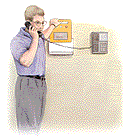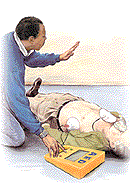|
| ||||
|
The Links in the Chain of Survival |

|
| |
| Early
Access: Call 911 (or the EMS system in your area) and get an AED!  |
Recognize an Emergency.
At this point the dispatcher may give you directions such as "Stay on the line until I tell you to hang up. Rescuers are being sent to your location. Please meet them and direct them to the scene." Remember, though, if you are alone, you must immediately begin performing CPR, the next link in the chain. |
|
| |
| Early CPR:
"Pump and Blow"  |
Begin Cardiopulmonary Resuscitation
(CPR).
Find Out if Your Community Has Enhanced
911. |
|
| |
Early
Defibrillation: Use the AED! |
Use the Automated
External Defibrillator (AED) to Treat Ventricular Fibrillation.
Most sudden cardiac arrest victims are in ventricular fibrillation (VF). VF is an abnormal, chaotic heart rhythm that prevents the heart from pumping blood. VF causes more cardiac arrests than any other rhythm (about 80% to 90% of cases). You must defibrillate a victim immediately to stop VF and allow a normal heart rhythm to resume. The sooner you provide defibrillation with the AED, the better the victim's chances of survival. If you provide defibrillation within the first 5 minutes of a cardiac arrest, the odds are about 50% that you can save the victim's life. But with each passing minute during a cardiac arrest, the chance of successful resuscitation is reduced by 7% to 10%. After 10 minutes there is very little chance of successful rescue. Public Access Defibrillation. The AHA promotes the most rapid possible defibrillation of victims of cardiac arrest. To do this the AHA wants to place AEDs in the hands of trained, nontraditional rescuers. These include police, security guards, and family members of patients at high risk for cardiac arrest. Public access defibrillation (PAD) programs place AEDs in homes, police cars, worksites, and public gathering places, under the supervision of licensed physicians. PAD rescuers must be trained in CPR and the use of an AED. When AEDs are readily available, rescuers can provide defibrillation within the first few minutes of out-of-hospital cardiac arrest. This dramatically increases the victim's chances of survival. Public access defibrillation programs and AED manufacturers should work with local EMS systems. Program authorities or manufacturers should notify EMS directors of AEDs placed in homes, businesses, or other public areas. Heartsaver AED. The AHA has developed the Heartsaver AED Course to support the public access defibrillation movement and specific PAD programs. The course is designed to help you learn how to give CPR and use an AED. These skills are essential in caring for the victim of cardiac arrest. |
|
| |
Early
Advanced Care |
Transfer to Advanced
Care. The fourth link in the Chain of Survival is advanced care. This link is provided by highly trained EMS personnel called "paramedics." Paramedics give basic life support and defibrillation as well as more advanced care. They can give cardiac drugs and insert endotracheal breathing tubes. These advanced actions (1) help the heart in VF respond to defibrillation or (2) maintain a normal rhythm after successful defibrillation. |
|
© 1999 American Heart Association. All rights reserved. Unauthorized use prohibited. |
Contact Us
Website Maintenance by Fusion Studios Inc.

